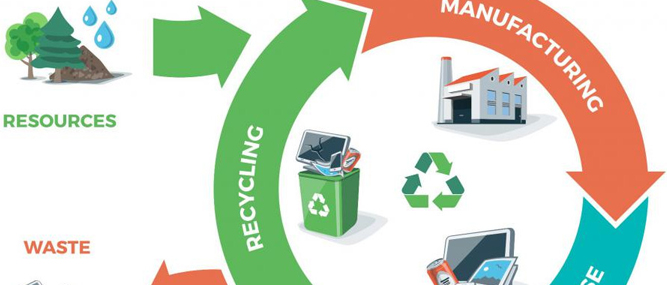Topics like sustainability, reuse and recycling are already clearly established in the marketing message of many wood pallet providers, but are we ready for the circular economy?
Acceptance of circular economy as an approach continues to gain traction in Europe, and is increasingly taking hold in North America. If your customers haven’t been already talking about it, they will soon be incorporating circular economy thinking into their approach to business best practices. The good news is that the pallet industry already does a lot of things right regarding circular thinking through reuse and recycling programs. If you have a solid sustainability message already, then you are already well positioned. So, what’s different about circular thinking?
To quote WRAP (The Waste and Resources Action Programme), a leading UK non-profit: A circular economy is an alternative to a traditional linear economy (make, use, dispose) in which we keep resources in use for as long as possible, extract the maximum value from them while in use, then recover and regenerate products and materials at the end of each service life.
How Circular Economy is Different Than Sustainability
Circular economy differs from the concept of sustainability in that it supports economic growth while preventing the loss of resources (and lost resources translate into garbage and pollution) into the physical environment. Sustainability, on the other hand, is more about avoiding the depletion of resources as well as environmental degradation. In a world where billions of people are looking for a better way of life, the concept of sustainability through slowing economic growth to conserve resources is an option that will be extremely hard to sell.
The circular economy doesn’t so much want us to use less “stuff” as creating new opportunities to share it (Think Uber, AirBnB, and yes, pallet pooling), reuse it and recondition it so that we do not need to extract natural resources, or discard or emit the remains of that stuff back into the physical environment.
From a circular perspective, concepts like sharing, reuse, repair, and reconditioning are a higher priority than recycling or disposal, because they help maintain the value of resources with the lowest level of intervention. That’s exactly the way many pallet markets work.
European pallet suppliers received early exposure to the circular movement, and were quick to point out how wood pallets align with the circular model. “Wood can be harvested now and in the far future from sustainably managed forests,” stated Rob van Hoesel, president of the European Federation of Wooden Pallet & Packaging Manufacturers (FEFPEB) back at the organization’s 2016 Congress. “In the EU as a whole the stock of timber is still growing and most forests are sustainably managed under FSC or PEFC certification schemes. This simple fact makes a world of difference compared to other materials such as iron or plastics.” Together with the fact they can be easily reused, repaired and then recycled into other products or biomass fuel, this means “wooden pallets and packaging are the ultimate example of circular thinking.”
In North America, CHEP now frequently discusses its “sharing” model in its public communications. CHEP states on its website, “We help customers become part of the circular economy through our principles of share and reuse.”
The U.S. reusable packaging industry has adopted the circular theme. “The packaging industry is dominated by straight lines and right angles, boxes and cube utilization,” Reusable Packaging Association President Tim Debus noted at last year’s PACK EXPO Show. “For the reusable packaging industry, however, perhaps it is the shape of a circle that illustrates the opportunity, how it can conserve resources and eliminate waste and how it can enhance performance in supply chains.”
Pallet Companies and Circular
In terms of the marketing message, I do not see a lot of difference between sustainability messaging and that which will be required for circular. It is more about the business opportunities created by customers increasingly awakening to the importance of reuse and resource sharing, and for everyone, looking at sharing opportunities to take advantage of under-utilized assets.
Prepare for purchasers to continue to ratchet up their game when it comes to circularity. Expect wood certification to become an increasingly popular requirement as buyers look for proof of renewable materials and products. It is worth noting that the two major certification schemes – the Forest Stewardship Council (FSC) and the Programme for the Endorsement of Forest Certification (PEFC) reported a year-on-year increase of 35 million hectares (7.5%) as of May 2017.
Expect customers to look for more reuse and sharing options that win on the cost per trip side of the equation as well as for circular aspirations. Pooling, custom retrieval systems, repair and ultimately recycling will probably continue to grow in importance with circular decision makers.
And maybe there is something to a circular or sharing mindset that will help reveal new opportunities for your business. Do you have a customer who has seasonal idle pallet inventories they could “share” (sell and then have sold back to them refurbished when needed)? One pallet business I know generates a revenue stream by “sharing” (renting) unused yard space for transport truck parking. Other options are renting trailers or providing other forms of mobile storage.
Models like AirBnB and Uber have made powerful statements, but I suspect there are many more “sharing” opportunities that are still untapped. Look to a circular economy focus to help unlock new opportunities in the pallet services space.




